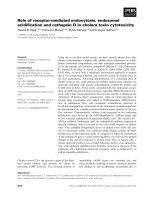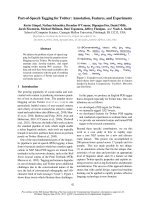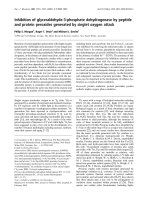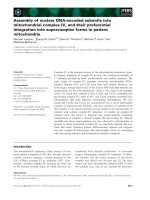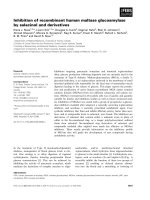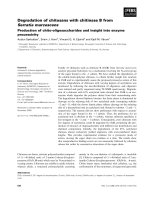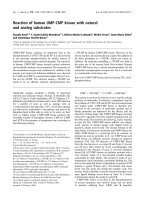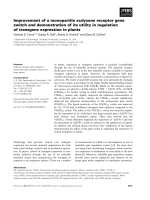Báo cáo khoa học: Injection of poly(b-L-malate) into the plasmodium of Physarum polycephalum shortens the cell cycle and increases the growth rate pot
Bạn đang xem bản rút gọn của tài liệu. Xem và tải ngay bản đầy đủ của tài liệu tại đây (371.81 KB, 7 trang )
Injection of poly(b-
L
-malate) into the plasmodium of
Physarum
polycephalum
shortens the cell cycle and increases the growth rate
Michael Karl
1
, Roger Anderson
2
and Eggehard Holler
1
1
Institut fu
¨
r Biophysik und Physikalische Biochemie der Universita
¨
t Regensburg, Germany;
2
Molecular Biology and Biotechnology,
University of Sheffield, UK
Poly(b-
L
-malate) (PMLA) has been reported as an uncon-
ventional, physiologically important biopolymer in plasmo-
dia of myxomycetes, and has been proposed to function in
the s torage and transport of nuclear proteins by mimicking
the phospho(deoxy)ribose backbone of nucleic acids. It is
distributed in the cytoplasm a nd especially in the nuclei of
these giant, multinucleate cells. We report here f or the first
time an increase in growth rate and a shortening of the cell
cycle after the injection of purified PMLA. By comparing
two strains of Physarum polycephalum that differed in their
production levels of PMLA, it was found that growth
activation and cell cycle shortening correlated with the
relative increases of PMLA levels in the cytoplasm or the
nuclei. Growth rates of a low PMLA producer strain
(LU897 · LU898) were increased by 40–50% while those of
a high producer strain (M
3
CVIII) were increased by only
0–17% in comparison with controls. In both strains,
shortening of the cell cycle occurred to a similar extent (7.2–
9.5%), and t his w as associat ed with similar increases in
nuclear PMLA levels. The effects showed saturation de-
pendences with regard to the amount of injected PMLA. A
steep rise of i ntracellular PMLA shortly a fter injection was
followed by the appearance of histone H1 in the cytoplasm.
The increase i n growth rate, the shortening of the cell cycle
duration and the appearance of H1 in the cytoplasm suggest
that PMLA competes with nucleic acids in binding to pro-
teins that control translation and/or transcription. Thus,
PMLA could play an important role in the coordination of
molecular p athways t hat a re responsible f or the synchronous
functioning of the multinucleate plasmodium.
Keywords
1
: cell cycle; g rowth rate; P hysarum polycephalum;
plasmodium; polymalic acid.
In the absence of cytokinesis, repeated nuclear divisions give
rise to giant multinucleate cells (plasmodia) in Physarum
polycephalum [1], a well studied representative of the
myxomycete family. One of the notable features of
plasmodia is the high synchrony of events during the cell
cycle. The maintenance of this synchrony over large cellular
distances must require an activity that accounts for the rapid
and ubiquitous distribution and coordination of protein
activities in the periodical cell cycle eve nts. W e h ave
previously identified the unusual polyanion poly(b-
L
-ma-
late) (PMLA) a s a specific component of the plasmodium
that fulfils the requirements for such a Ôdistributing activityÕ
[2,3]. Its level in the nuclei i s kept constant by constitutive
synthesis and secretion of excess polymer from the cyto-
plasm to the culture medium, and the levels in the nuclei for
different strains are of the same magnitude [4]. PMLA binds
reversibly to histones, DNA polymerases, a nd other DNA-
interacting proteins, thus favouring the formation of large
complexes consisting o f a variety of proteins. The binding
involves specifically the array of negative carboxylates on
the PMLA chain that is isosteric with the array of
phosphates in nucleic acids [2,5–9]. This complex-forming
property and the high mobility seen for the fluorescently
labelled polymer in plasmodia [10] suggest that PMLA
could function as a constituent of the postulated distributing
activity.
In addition to functioning as a distributing activity,
PMLA might act as a synchronizing agent by competing
with nucleic acids for the binding of structural proteins,
enzymes, and regulatory proteins. A recent analysis of DNA
synthetic activities in extracts of plasmodia revealed a cell
cycle dependent inhibition and activation of DNA poly-
merases. This could be explained by the binding of DNA
polymerases to endogenous PMLA in competition with
periodically synthesized histones or certain other proteins
[11]. Competition of this kind is likely to inhibit various
kinds of activities involving the binding of proteins to
nucleic acids, and it c ould affect cell g rowth a nd cell cycle
duration.
The distributing activity of PMLA and the efficiency of
competition between PMLA and nucleic acids would both be
influenced by the concentration of PMLA. An abnormal
increase in PMLA level would therefore be expected to
modulate growth properties. To test this prediction, we
injected purified PMLA into plasmodia and measured the
cytoplasmic and nuclear levels of the polymer in parallel with
changes in growth rate and cell cycle duration. The
Correspondence to E. Holler, Institute fu
¨
r Biophysik und Physikalische
Biochemie der Universita
¨
t Regensburg, D-93040 Regensburg,
Germany. Fax: +49 941943 2813, Tel.: +49 941943 3030,
E-mail:
Abbreviations: PMLA, poly(b-
L
-malic acid) and poly(b-
L
-malate).
Enzyme: phosphatase (EC 3.1.3.16).
Note: A website is available at -regensburg.
de/biophysik
(Received 2 5 May 2004, revised 5 July 2004, accepted 23 July 2004)
Eur. J. Biochem. 271, 3805–3811 (2004) Ó FEBS 2004 doi:10.1111/j.1432-1033.2004.04299.x
investigation included wild-type and mutant strains of
P. polycephalum with distinctly different levels of PMLA in
the cytoplasm, but more or less comparable levels in the
nuclei. We found that increased cytoplasmic and nuclear
levels of PMLA induced a strain specific enhancement of cell
growth and an equal (between strains) shortening of the
cell cycle.
Materials and methods
Strains and materials
The following strains of P. polycephalum were used
(Table 1): t he Ôhigh PMLA producingÕ strains M
3
CVIII
ATCC 96951 (yellow, wild-type), M
3
CVII ATCC 204388,
CH813 · LU861 (yellow), LU688 (yellow); the Ômedium
PMLA producingÕ strain OX 110 · RA271 (yellow); and
the Ôlow PMLA producingÕ strains LU897 · LU898 (white,
mutant) [ 12], and LU887 (white, mutant). Plasmodia were
routinely g rown for 1.5–2 days at 24 °C, except M
3
CVIII,
which was grown at 27 °C.Theaxenicgrowthmediumhas
been described [13]. Macroplasmodia were started from the
fusion of microplasmodia (15–20 mg) on the surface of 2%
(w/v) agar in 8-cm plastic Petri-dishes [14]. PMLA, potas-
sium salt, was purified as described [15], having M
r
¼
50 kDa and a polydispersity ¼ 2.0 [16]. Anti-(histone H1)
Ig (bovine) raised in sheep (diluted 1 : 500 ELISA), anti-
(histone H2B) ( bovine) raised in sheep (1 : 2000), anti-
(histone H3) Ig (bovine, subgroup f3) raised in sheep
(1 : 2000), anti-(histone H2A + H4) (calf thymus) raised in
sheep (1 : 1 000) were all from B ioTrend (Cologne, Ger-
many)
2
. Peroxidase-coupled anti-IgG (sheep) raised in rabbit
was from Calbiochem. All anti-histone immunoglobulins
bound to histones purified from P. polycephalum [17] in
ELISA and Western blotting. The specificity was charac-
terized by Western blotting and ELISA of purified total
histones and nuclear and chromatin extracts of P. poly-
cephalum. A low d egree of cross reaction of anti-H1 Ig with
the core histones was observed that was constant and
negligible during ELISA under t he conditions used; other-
wise, the immunochemical responses of the a ntibodies were
specific. Lambda protein phosphatase (400 000 unitsÆmL
)1
;
> 300 000 UÆmg protein
)1
) w as from Calbiochem. A ll
other reagents were f rom Merck or Sigma and were of the
highest purity available.
Microinjection, growth rate
Before each macroplasmodium received a microinjection, a
small piece was cut out and the stage of the cell c ycle
determined as described previously [18]. The stages could be
fairly well predicted by c alculation, taking into account the
time elapsed after the fusion and the known length of
the cell cycle. The injection solution of 1–4 lL contained
15–200 mgÆmL
)1
PMLA, p otassium salt, or a reference
solution containing either KCl,
L
-malate (potassium salt),
poly(
L
-glutamate) (potassium salt) or distilled water. Solu-
tions were injected into veins in parallel to the protoplasmic
streaming at fi ve different points distributed over the
plasmodium. Fluorescently l abelled PMLA [ 10] s howed
an even distribution over > 97% of the plasmodium within
less t han 20 min. A Leitz
3
micromanipulator (Wetzlar,
Germany) equipped with a laboratory course binocular
(Wild Heerbrugg, Heerbrugg, Switzerland)
4
and Kwik-Fil
TM
borosilicate capillaries (World Precision Instruments,
Sarasota, FL, USA)
5
were used. Times of injections were
either early S -phase following the third mitosis or early
G
2
-phase following the second mitosis. Sizes of plasmodia
were then of the order of 4–7 cm
2
. The third metaphases
were observed at 25.6 ± 0.5 h (mean ± SD, 10 replicates)
after the fusion of microplasmodia for the yellow M
3
CVII
strain, at 2 5 ± 0.5 h for t he white mutant strain
LU897 · LU898, and at 21 ± 0.4 h for the white mutant
strain LU887. Cell growth was measured at various times
and interpolated for 5 h after the injectio n. The duration of
the nuclear division cycle was measured microscopically [18]
between the third and the fourth mitosis, when at least 60%
of the nuclei were in metaphase.
To follow the growth of a p lasmodium in a noninvasive
manner, its surface area w as measured at successive times
[19]. The plasmodia did not contact the walls of the agar
plates at any time. The s urface areas correlated significantly
with the weight of (wet) plasmodia measured after their
removal from the agar plates. One square centimete r
corresponded to 18.3 ± 0.5 m g plasmodium (mean ± SD,
six independent measurements).
Table 1. PMLA contents and numbers of nuclei in various strains of P. polycephalum. All results are given in means and standard deviations of at
least three independent measurements.
Strain Colour (genotype)
a
PMLA contents (lgÆg plasmodium
)1
) in extracts of:
Number of nuclei
(10
8
Æg plasmodium
)1
)
Nuclei Cytoplasm Culture medium
M
3
CVII Yellow (whiA
+
/whiA
+
)
a
200 ± 75
b
60 ± 15
b
High 2.5 ± 0.4
c
450 ± 45
c
350 ± 25
c
M
3
CVIII Yellow (whiA
+
/whiA
+
) 189 ± 20
b
63 ± 14
b
High 2.0 ± 0.5
c
340 ± 28
c
350 ± 25
c
CH813 · LU861 Yellow (whiA
+
/whiA
+
) 550 ± 60
b
460 ± 90
b
Very high 5 ± 1
b
LU688 Yellow (whiA
+
) 1730 ± 150
b
1000 ± 60
b
High 4.8 ± 1
b
OX110 · RA271 Yellow (whiA1/whiA
+
)18±3
b
47 ± 15
b
Low 0.2 ± 0.05
b
LU897 · LU898 White (whiA1/whiA1) 270 ± 25
b
Not detectable
b
Not detectable 1.8 ± 0.2
b
LU887 White (whiA1) 130 ± 16
b
Not detectable
b
Not detectable 2.0 ± 0.5
c
260 ± 15
c
60 ± 15
c
a
Presumed genotype.
b
Microplamodia.
c
Macroplasmodia: G
2
-phase.
3806 M. Karl et al. (Eur. J. Biochem. 271) Ó FEBS 2004
Quantitative ELISA
Extracts of cytoplasm, nuclei, and chromatin were diluted
10
4
)10
8
-fold in buffer (1.59 g Na
2
CO
3
, 2.93 g NaHCO
3
in
1L H
2
O, pH 9.6) and coated in varying amounts onto
microwell plates for 3 h at 37 °C. The plates were washed
with phosphate/saline (2 m
M
KH
2
PO
4
,8m
M
Na
2
HPO
4
,
137 m
M
NaCl, 4 m
M
KCl pH 7.4), blocked o vernight in a
solution of 2.5 mgÆmL
)1
milk powder in phosphate/saline
and 0.05% (v/v) Tween 20 at 4 °C, followed by f our
changes of washing solution, containing 0.9% (w/v) NaCl,
0.05% (v/v) Tween 20, before incubation with 50 lLper
well anti-histone Igs for 1.5 h at 37 °C. After three changes
of washing buffer, the second antibody (peroxidase conju-
gated) was administered a t 50 lLperwellfor1hat37°C.
Following four changes of washing buffer, plates were
incubated with 50 lL per well of a solution of (o-phenylene-
diamine dihydrochloride) Fast Tablets
TM
(Sigma) for
25 m in at room temperature in the dark. A fter the addition
of 16 lLperwellof3
M
HCl, the extinction was read at
490 n m and reference 630 nm wavelengths i n a Micro-
Reader Dynatech MR700
6
(Dynatech Laboratories Inc.,
Chantilly, VA, USA). The readings were plotted as a
function of A
595
units (protein assay according to Bradford
[20]). Increments of the linear fits through t he origin were
used to calculate the relative antigen concentrations in units
of 10
5
· A
490
/A
595
. The ELISA for H1 depended on the
degree o f phosphorylation, and no a ttempts were made to
standardize the ELISA readings on an H1 mass basis. Series
of measurements were compared after standardization with
a reference sample prepared by the same method. PMLA
in the extracts did not affect ELISA readings.
Other methods
Cytoplasmic, nucleoplasmic and chromatin extracts were
prepared according to a modified method of Angerer a nd
Holler [6]. One gram of plasmodia was lysed in 11 mL of
homogenization buffer and centrifuged for 10 m in at
2000 g. The supernatant was removed and centrifuged
again at 20 000 g; the resulting supernatant w as the
cytoplasmic extract. The pellet was treated with nuclei
extraction buffer [6] and centrifuged at 20 000 g;the
supernatant was referred to as the nuclear extract. The
residual pellet was incubated with an equal volume
containing sodium carbonate buffer and 10
M
NaCl,
pH 11.4; the supernatant after 20 000 g centrifugation
was the chromatin extract. This fractionation system was
optimal with regard t o the preservation of nuclei during the
preparation of the cytoplasmic extract, and the same r esults
were obtained with t he homogenization buffer of Loidl and
Gro
¨
bner [21]. Nuclei were counted in the pellets using a
Neubauer hemocytometer before extraction for calculation
of the PMLA content. The purification of nuclei over a
Percoll gradient was not used, as nuclei prepared in this way
were devoid of PMLA [8]. For whole plasmodia, nuclei were
counted in alcohol-fixed smears under the phase contrast
microscope or after staining with 4¢,6¢-diamino-2-phenyl-
indole. Plasmodium mass was assessed after removal of
adhering liquid with tissue paper. Values are given as
means ± SD for measurements p erformed at least i n
triplicate.
To dephosphorylate histone H1, extracts were incubated
for 30 m in at 30 °C in the presence of 800 U Lambda
protein phosphatase, 50 m
M
Tris/HCl pH 7.5, 5 m
M
dithiothreitol, 2 m
M
MnCl
2
,and100lgÆmL
)1
BSA. Poly-
malate was quantitated as described by Karl et al. (2003)
[10]. DNA was measured by the me thod described by Gold
and Shochat (1980) [22].
Results and Discussion
Growth rate and duration of cell cycle
In the intial experiments, PMLA was injected into macro-
plasmodia, and growth was measured in comparison to
control plasmodia injected with water (Ômock-injectedÕ
plasmodia). The yellow strain M
3
CVIII produces and
secretes high amounts of PMLA, while the white strain
LU897 · LU898 produces considerably less PMLA
(Table 1). Both strains grew very slowly during the first
few hours following fusion of microplasmodia, before they
assumed an approximately constant or slightly exponential
growth rate. E ighteen hours after fusion, each plasmodium
was injected with 200 lgPMLA(Ômock injectedÕ plasmodia
received an equal volume of water), and growth was allowed
to continue until 45 h after fusion (Fig. 1). Sizes (corres-
ponding to masses, see Materials and methods) were
measured 5, 20, and 27 h after injection. The y ellow
plasmodia grew faster than the white ones, but PMLA-
injected plasmodia of both strains grew at comparable rates.
After 45 h, the sizes of the PMLA-injected yellow plasmo-
dia were larger by 20% (P<0.007) and the PMLA-
injected white plasmodia were larger by 44% (P<0.004)
than their water-injected control counterparts. Noninjected
plasmodia grew at the same rates as the water-injected
controls (data not shown). Thus, the effect of PMLA on
growth was greater on the low PMLA producing white
plasmodia, which c ontained l ess P MLA, than on the h igh
PMLA producing yellow plasmodia (Table 1). The greater
sizes persisted until the end of the experiment.
We then tested whether the plasmodial size (growth rate,
Fig. 2A,C,E) and the duration of the cell cycle (Fig. 2B,D,F)
depended on the dose of injected PMLA, over the range
0–400 lg PMLA (A–D). The times of the injections were
early G
2
-phase before mitosis III (Fig. 2C,D) or early
S-phase, following mitosis III (Fig. 2A,B,E,F), in order to
see whether mitosis influenced the efficacy of the PMLA-
induced phenomena. Plasmodial sizes were measured at 5 h
after injection (Fig. 2A,C,E) and cell cycle duration between
the third a nd fourth mitosis (Fig . 2 B,D,F). The ratio of cell
sizes in the figures is expressed relative to control (mock ¼
water-injected) plasmodia a nd reflects the growth rate. To
test for specificity, 0–300 lg poly(
L
-glutamate) were injected
in control experiments (Fig. 2E,F). Poly(
L
-glutamate) was
chosen as a negative control because it is not isosteric with
the (deoxy)ribosephosphate backbone of nucleic acids [5].
Control e xperiments to test for osmotic effects were carried
out with KCl and
L
-malate (potassium salt) at equimolar
amounts with the malyl residues of injected PMLA.
The PMLA-injected plasmodia grew to be larger than the
mock-injected ones, with a dose–response relationship
indicating that the system w as approaching saturation at
high doses of PMLA (Fig. 2A,C). The low PMLA producer
Ó FEBS 2004 Polymalate effects growth and cell cycle (Eur. J. Biochem. 271) 3807
(mutant white strain LU897 · LU898, solid lines in Fig. 2)
showed a greater increase in size than the high PMLA
producer (yellow strain M
3
CVIII, broken line in Fig. 2).
Thus, after injection of 400 lg PMLA in S-phase, the yellow
plasmodia were larger by 17% (P<0.015) that their
mock-injected contro ls (Fig. 2A, dashed line) and not
detectably larger after injection in G
2
-phase (Fig. 2C,
dashed line). In contrast, the white plasmodia were larger
by 50% (P<0.0003) than the mock-injected controls after
injection in S-phase (Fig. 2A, continuous line), and larger
by 40% (P<0.0006) after injection in G
2
-phase Fig. 2C,
continuous line). The differences between the strains are
highly significant and are in agreement with those in Fig. 1.
The cell cycle duration decrease d significantly in com-
parison with the mock-injected plasmodia, the overall
changes being similar for the two strains a nd indepen dent
of the injection times. Following injection of 400 lgPMLA,
the decrease was 8.2% (P<0.0012) f or yellow plasmodia
injected in S-phase or G
2
-phase (Fig. 2 B,D, dashed lines),
and 9.5% (P<0.0003) and 7.2% (P<0.0005) for white
plasmodia injected in S-phase or G
2
-phase, respectively
(Fig. 2 B,D, continuous lines). The saturation behaviour of
the dose dependence was less pronounced than that of the
plasmodium size. The effects of injecting at different time s
(S- and G
2
-phase) were similar and did not give evidence for
a control point, except for the failure of yellow plasmodia to
increase in size after injection in early G
2
-phase. This could
indicate that during the 5 h after injection in early G
2
-phase,
growth stimulation was low because plasmodia a lready
contained high levels of PMLA.
To examine the effect on cellular p rotein and DNA
concentrations, 200 lg PMLA was injected in early S-phase
(after mitosis III) and the contents compared with those o f
mock-injected plasmodia. After 7 h, the protein contents
(mgÆg plasmodia
)1
) were: 10.9 ± 1.2 (mock-injected) and
11.1 ± 1.2 (PMLA-injected) for the yellow strain
M3CVIII; and 14.6 ± 1.5 (mock) and 14.9 ± 1.7 (PMLA)
for the white strain LU897 · LU898. The DNA contents
(lgÆg plasmodia
)1
) were: 522 ± 18 (mock) and 540 ± 18
(PMLA) for the yellow strain; and 690 ± 12 (mock) and
744 ± 30 (PMLA) for the white s train. Thus, the concen-
trations for PMLA- and mock-injected plasmodia were not
significantly different (P > 0.05 at 95% confidence levels).
Also injections of either
L
-malate, KCl or poly(
L
-glutamate),
potassium salt (Fig. 2E,F) at relevant concentrations had
no significant effect on size or ce ll cycle duration (P >0.05
at 95% co nfidence levels). These results showed that the
effects were specific and not caused by an increased
osmolarity or availability of malate as a metabolite.
Distribution kinetics of injected PMLA
A comparison o f t he results i n Figs 1 and 2 (A,C) reveals
that the low PMLA-producing w hite strain manifests a
larger increase in the growth rate than the high PMLA-
producing yellow strain, while almost no difference between
the strains is seen for the cell cycle duration. In the following
discussion, these phenomena will be related to t he changes
in the amounts of PMLA in cytoplasmic and nuclear
extracts. As shown in Table 1, the PMLA contents of nuclei
extracted f rom the high PMLA producing (M
3
CVIII) and
the low PMLA producing (LU897 · LU898) strains are
comparable, while the PMLA concentrations in cytoplasmic
extracts differ considerably. A similar relationship is seen for
strains M3CVII and LU887, which also represent high and
low producers of PMLA (Table 1 ). In order to study
changes in the levels of PMLA in cytoplasm and nuclei, we
injected 400 lg of the polymer into M3CVII and LU887
plasmodia (weights of 150 mg) and measured the PMLA
contents of nuclear and cytoplasmic extracts. The results in
Fig. 3A,B for the low PMLA-producing strain LU887 show
an immediate increase after injection, peaking at approxi-
mately 2.8 mgÆgplasmodium
)1
in the nuclear extract
(Fig. 3 A) and at 350 lgÆg plasmodium
)1
in the cytoplasmic
extract (Fig. 3B). The PMLA contents in mock-injected or
noninjected plasmodia remain constant (Fig. 3B and [3]).
Similar increases were found for the yellow strain M
3
CVII
(data not shown). Thus, the absolute increases in PMLA
levels in the extracts were the same for the white and the
yellow strains. N evertheless, because the level in the
cytoplasm of w hite plasmodia before injection was v ery
low (Table 1), the relative increase in these str ains was
considerably higher than for the yellow strains, which
Fig. 1. Effect of i njected PMLA on gro wth. Volumes of 2 lLPMLA
solution (200 lg PMLA, dashed lines) or distilled water (mock-injec-
ted, continuo us lines) were injected at the time indicated by the arrows.
The size of p lasmodia was measured in terms of the surface area
covered by each plasmodium (1 cm
2
corresponding to 18.3 ± 0.5 mg
plasmodium, see Materials and methods). (A) Yellow wild-type strain
M
3
CVIII. (B) White mutant strain LU897 · LU898. Standard devi-
ations of three independent measurement s are indicated.
3808 M. Karl et al. (Eur. J. Biochem. 271) Ó FEBS 2004
already had high levels of cytoplasmic PMLA before
injection. Assuming similarity between the two white strains
on one hand and the two yellow strains on the other the
different relative increases of PMLA in the cytoplasmic
extracts from yellow and white plasmodia can be seen to
correlate qualitatively with the different increases in growth
rates (Fig. 2A,C). In contrast, the PMLA contents of
nuclear extracts from yellow and white plasmodia are
similar (Table 1), and this correlates with the almost eq ual
degree of shortening of the cell cycle (Fig. 2B,D).
The kinetics of PMLA distribution were remarkable. (a)
PMLA contents increased rapidly after injection, in agree-
ment with previous findings [10]. A calculation shows t hat
the injected 400 lgPMLA(into 150 mg p lasmodium)
was recovered in the extracts. (b) The amounts of free
L
-malate in the cytoplasmic/nuclear extracts were
260 ± 30 lg/45 ± 8 lg and constant over the period of
the i nvestigation (data not shown). PMLA w as not
detectably degraded, but was instead secreted into the
culture medium [3,10]. ( c) Clearance from the plasmodium
in 4 h (Fig. 3A,B) corresponded to a clearance activity of
600 lgPMLAÆh
)1
Æg plasmodium
)1
and compares with the
rate of 920 lgÆh
)1
Æg plasmodium
)1
secretion by micro-
plasmodia (60 h after inoculation) [23]. These results are in
agreement with the homeostatic model described previously
[3] and show that plasmodia do not tolerate artificially
increased levels of PMLA. The data in Table 1 allow
calculation and comparison of the PMLA contents of nuclei
in a variety of strains. These nuclear contents vary relatively
little, between 0.65 pmol for LU887 and 3.6 pmol for
LU688, whereas the variation in cytoplasmic contents is
much greater (> 1000-fold). This suggests that the nuclear
concentration of PMLA is regulated to maintain a relatively
constant, high level in all strains.
Fig. 2. Effects of polymalate injection on growth and duration of the cell cycle. Variable amounts of PMLA (A–D) or poly(
L
-glutamate) (E,F) were
injected in early S-phase (40 ± 5 min afterthethirdmetaphase;A,BandE)orinG
2
-phase (180 ± 10 min after the second metaphase; C,D,F).
M
3
CVIII (yellow, high PMLA producer; j) and LU897 · LU898 (white, low PMLA producer; d). The sizes of plasmodia were measured after
5 h and the cell cycle duration between the third and fourth mitoses. The sizes are given relative to those of mock-injected plasmodia, which were
grown in parallel, and indicate the ratio of growth rates (Fig. 1). S tandard deviations refer to at least three independent measurements.
Ó FEBS 2004 Polymalate effects growth and cell cycle (Eur. J. Biochem. 271) 3809
Transient appearance of histone H1 in the cytoplasm
We suspected that the mechanism(s) underlying the increase
in the growth rate and the shortening of the cell cycle might be
related to the ability o f PMLA to form c omplexes with
nucleic acid binding proteins and thus to compete with
nucleic acids. Known e xamples are histones, especially H1
[5,6]. Therefore we tested whether free H1 and core histones
(probably in complexes with PMLA) could be d etected as a
consequence of the injection o f PMLA. Using quantitative
ELISA on cytoplasmic extracts (Fig. 3C), increase d levels of
H1 were indeed detected. The increase followed the injection
of PMLA with a delay of 1–2 h. As epitopes had been
masked by phosphorylation in vivo, a higher amount of H1
was detected after dephosphorylation with Lambda protein
phosphatase (Fig. 3C, j). Injection of
L
-malate did not
provoke H1 appearance (Fig. 3, h). ELISA with specific
antibodies did not detect an increase of the core histones
(data not shown). Also, the nuclear extract and chromatin
extract did not indicate a PMLA-dependent variation in
histone content.
Conclusion
Our main finding was that plasmodia responded t o an
artificial, unprogrammed increase in t he cellular content of
PMLA by an in crease in size (growth r ate) and by a
shortening of the cell cycle duration. This conclusion is
based on the study of more than 120 plasmodia, which gave
relatively high experimental reproducibility a nd results that
are statistically highly significant. The effect was structure
specific for PMLA. Swelling of plasmodia or an accumu-
lation of slime after injection could be ruled ou t as
explanations, b ecause concentrations of protein a nd DNA
remained unaffected. Th e possibility that PMLA m ight be
hydrolysed to
L
-malate and th en used as a carbon and
energy source was e xcluded on the basis t hat not only was
PMLA hydrolysis absent (this work and [3,10]) but that
injection of
L
-malate did not reproduce the effect. It was
concluded that acceleration o f the cell cycle a nd enhanced
growth were functional effects of injected PMLA.
We propose that the underlying mechanism by which
PMLA increases the growth rate and shortens the duration
of the cell cycle is the polymer-inherent isosterism of the
carboxylates with the array of phosphates in nucleic acids
and, consequently, the competition with nucleic acids in the
(reversible) binding of p roteins, such as histones and DNA
polymerases [5,6,10]. An example of competition between
DNA polymerases and histones in the binding of PMLA
has been demonstrated in a purified system [2] and was
suggested as an explanation for the periodic activation of
DNA polymerases in the cell cycle [11]. The degree of
competition depends on the concentration of free PMLA,
DNA, and the binding affinity and follows saturation
functions. It i s speculated that the levels of protein
complexes of intrinsic PMLA and nuc leic acids are ÔtunedÕ
for optimal function in the plasmodium and that an
unscheduled increase in PMLA by injection perturbs this
tuning and causes the observed effects. Different proteins
and nucleic acids gave rise to the different dose depend-
encies in Fig. 2. For instance, in competing with mRNA
for t he binding of regulatory proteins in the cytoplasm,
PMLA might derepress translation activity. Examples of
translational regulation are known for higher eukaryotes:
mRNAs are masked during gametogenesis until embryonic
development [24]. In another example, the expression of
maternal proteins is suppressed in mouse oocytes by the
binding of MSY2 protein to mRNA [25]. Also, PMLA
might b ind to histones a nd enhance the rates of transcrip-
tion by facilitating chromatin remodelling. Our finding of
high levels of free (probably PMLA-bound) H1 in the
cytoplasm after injection supports this assumption. High
concentrations of (phosphorylated) linker histone H1 in the
cytoplasm during S-phase and G
2
-phase of the cell cycle
but not in G
1
-phase have been reported for HeLa cells [26].
In some other mammalian cells, examples of cytoplasmic
accumulation of H1, but not of core histones have been
reported [27].
Fig. 3. Levels of polymalate and histone H1 during the cell cycle after
injection of 400 lg PMLA per macroplasmodium (white mutant strain
LU887, 150 mg) in early S-phase (arrow). (A) PMLA in the nuclear
extracts. (B) PMLA in the cytoplasmic extracts; j, noninjected
macroplasmodia. ( C) E LISA o f h istone H 1 in cytoplasmic extracts
without (m) and after incubation with Lambda protein phosphatase
(j);onerelativeunit¼ 10
5
· A
490
/A
595
(A
490
ELISA readings, A
595
protein readings according to th e assay described by B radford [20], see
Materials and methods). Controls refer to macroplasmodia having
received 400 lg
L
-malate (h) and to no ninjected m acroplasmodia (s).
The symbo l M3 refers to the t hird mitosis after the fusion of micro-
plasmodia. Mean values and SDs of at least three i ndependen t meas-
urements are indicated.
3810 M. Karl et al. (Eur. J. Biochem. 271) Ó FEBS 2004
One may wonder why the large increase in PMLA
content after injection w as par alleled b y only modest
changes in growth and cell cycle duration. However, we
do not know how great an effect should be expected. If
we assume that certain PMLA–protein complexes are
involved in growth and cell cycle timing, then the size of
the observed effect will depend on the amount of such
newly formed PMLA–protein complexes. If the proteins
are already almost completely saturated by intrinsic
PMLA before the injection, even large amounts of
injected PMLA will not give rise to significant increases
in the levels of these complexes and thus will not induce
large effects. On the basis of these considerations, the
greater effect on growth in Fig. 2A,C can be explained by
assuming lower levels of c ertain PMLA–protein complexes
in white p lasmodia than in yellow plasmodia before the
injection ( because t here is much less PMLA in the
cytoplasm of white plasmodia; Table 1). By the same
token, the equal (between-strains) effects on the cell cycle
duration (Fig. 2B,D) might reflect almost identical levels
of certain PMLA–protein complexes in the nuclei of w hite
and y ellow strains (containing similar a mounts of PMLA;
Table 1 ).
The results provide evidence not only that PMLA
functions as a storage and carrier molecule for certain
proteins [6], but also that it may be involved in molecular
events concerned with growth and cell cycle duration in
plasmodia. Because t hese events are synchronized, PMLA
may a lso p lay a role in synchronization. The f undamental
mechanism of its function is mimicry of the charge array on
the nucleic acid backbone and competition with nucleic
acids for binding to specific proteins. A full understanding
of this mechanism remains to be established.
References
1. Burland, T.G., Solnica, K.L., Bailey, J., Cunningham, D.B. &
Dove, W.F. (1993) Patterns of i nheritance, development and the
mitotic cycle in the p rotist Physarum polycephalum. Adv. M icrob.
Physiol. 35, 1–69.
2. Fischer, H., Erdmann, E.S. & Holler, E. (1989) An unusual
polyanion from Physarum polycephalum that inhibits homologous
DNA polymerase a in vitro. Biochemistry 28, 5219–5226.
3. Sc hmidt, A., Windisch, C. & Holler, E. (1996) Nuclear accumu-
lation and homeostasis of the unusual polymer b-poly(
L
-malate)
in plasmodia of Physarum polycephalum. Eur. J. Cell. Biol. 70 ,
373–380.
4. Rathberger, K ., Reisner, H., Willibald, B.H., Molitoris, H P. &
Holler, E. (1999) Comparative synthesis and hydrolytic degrada-
tion of poly(
L
-malate) by myxomycetes a nd fu ngi. Mycol. Res.
103, 513–520.
5. Holler,E.,Achhammer,G.,Angerer,B.,Gantz,B.,Hambach,C.,
Reisner, H., Seidel, B., Weber, C., Windisch, C., Braud, C. & Vert,
M. (1992) Sepcific inhibition of Phys arum polycephalum DNA-
polymerase-a-primase by poly(b-
L
-malate) and related polyani-
ons. Eur. J. Biochem. 206,1–6.
6. Angerer, B. & Holler, E. (1995) Large complexes of beta-poly
(
L
-malate) with DNA polymerase alpha, histones, and other
proteins in nuclei of growing plasmod ia of Physarum poly-
cephalum. Biochemistry 34 , 14741–14751.
7. Achhammer, G., W inkler, A., Angerer, B. & H oller, E. (1995)
DNA polymerase d of Physarum polycephalum. Curr. Genet. 28,
534–545.
8. Doerhoefer, S ., Khodyre va, S., Safronov, I.V., W lassoff, W.A .,
Anarbaev, R., Lavrik, O.I. & Holler, E. (1998) Molecular con-
stituents of the replication apparatus in the plasmodium o f
Physarum polycephalum: identification by photoaffinity labelling.
Microbiology 144, 3181–3193.
9. Karl, M. & Holler, E. (1998) Multiple polypeptides immuno-
logically related to b-poly(
L
-malate) h ydrolase (polymalatase)
in the plasmodium of the slime mold Physarum polycephalum.
Eur. J. Biochem. 251, 405–412.
10. Karl, K., Gasselmaier, B., Krieg, R. & Holler, E. (2003) Locali-
zation of fluorescence-labeled poly(malic acid) to the nuclei of the
plasmodium of Physarum polycephalum. Eur. J. Biochem. 270,
1536–1542.
11. Do erhoefer, S., Windisch, C., Angere r, B., Lavrik, O.I., Lee, B S.
& H oller, E. (2002) The D NA-polymerase inhibiting activity of
poly ( b-
L
-malic acid) in n uclear extr act during the cell cycle of
Physarum polycephalum. Eur. J. Biochem. 269, 1253–1258.
12. Anderson, R.W. (1977) A plasmodial colour mutation in the
myxomycete Physarum polycephalum. Genet. Res. 30, 301–306.
13. Daniel, F.W. & Baldwin, H.H. (1964) Methods of culture for
plasmodial myxomycetes. Methods Cell Physiol. 1, 9–14.
14. Nygaard, O.P. & Guttes, S.R.H.P. (1960) Nucleic acid metabolism
in a slime mold with synchronous mitosis. Biochim. Biophys. Acta
38, 298–306.
15. Holler, E. (1997) Pol y(malic acid) f rom natural sources. In
Handbook of Engineering Polymeric Materials. (Cheremisinof,
N.P., ed.), pp. 93–103. Marcel Dekker, New York.
16. Lee, B S., Vert, M. & Holler, E. (2002) Water-soluble aliphatic
polyesters: poly(malic acid)s. I n Biopolymers 3a (Doi,Y.&
Steinbu
¨
chel, A., eds), pp. 75–103. Wiley-VCH, Weinheim.
17. Albert, P., Lacorre-Arescaldino, I. & Toublan, B. (1993) High
resolution polyacrylamide gel electrophoresis of Physarum po ly-
cephalum hist ones: improved resolution of variants and mod ified
forms. Anal. Biochem. 209, 224–227.
18. Mohberg, J. (1982) Recognition of mitosis. In Cell Biology of
Physarum and Didymium (Aldrich, H.C. & Daniel, J.W., eds), pp.
273–276. Academic Press, New Y ork.
19. Wright, M ., Lacorre-Arescaldino, I., Macquet, J.P. & Daffe
´
,M.
(1984) Introduction o f polyploid nuclei in the plasmodium of
Physarum polycephalum by antitumor compounds. Cancer Res.
44, 777–783.
20. Bradford, M.M. (1976) A rapid and sensitive method for the
quantitation of microgram quantities of protein utilizing the
principle of protein-dye binding. Anal. B iochem. 72, 248–254.
21. Loidl, P. & Gro
¨
bner, P. (1987) Histone synthesis during the cell
cycle of Physarum polycephalum. Synthesis of different histone
species is not under a common regulatory control. J. Biol. Chem.
262, 10195–10199.
22. Gold, D.V. & Shochat, D. (1980) A rapid colorimetric assay for
the est imation of microgram quantities of DNA. Anal. B iochem.
105, 121–125.
23. Lee, B S . & Holler, E. (1999) Effe cts o f culture cond itions on
b-poly(
L
-malate) produc tion by Physarum polycephalum. Appl.
Microbiol. Biotechnol. 51, 647–652.
24. Sommerville, J. & Ladomery, M. (1996) Transcription and
masking of mRNA in germ cells: involvement of Y-box proteins.
Chromo so ma 104, 469–478.
25. Yu, J., Hecht, N.B. & Schultz, R.M. (2002) Expression of MSY2
in mouse oocytes and preimplantation embryos. Biol. Reprod. 65,
1260–1270.
26. Bleher,R.&Martin,R.(1999)Nucleo-cytoplasmictranslocation
of histone H1 during HeLa cell cycle. Chromosoma 108, 308–816.
27.
7
Zlatanova, J.S., Srebreva, L.N., Banchev, T.B. & Tsanev, K.G.
(1990) Cytoplasmic pool of histone H1 in mammalian cells. J. Cell
Sci. 96, 461–465.
Ó FEBS 2004 Polymalate effects growth and cell cycle (Eur. J. Biochem. 271) 3811
